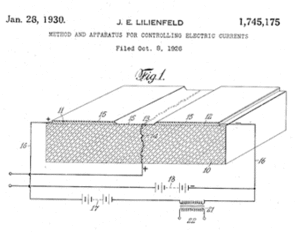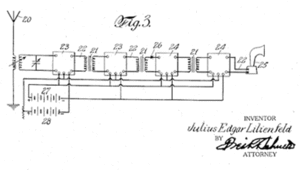A Very Early Conception of a Solid State Device
Introduction
Invented at Bell Telephone Laboratories between 1945 and 1948, many consider the transistor to be one of the most important inventions in 20th century technology. The story of the first working transistor underscores the power modern industrial laboratories have had to coordinate scientific discovery in the pursuit of technological breakthroughs. It is about great intellectual leaps and driving ambition. But while the story has been told and retold to scientists and engineers for years, only a small circle of history buffs and scholars know that the pursuit of the solid-state amplifier has an even longer history than the transistor. This quest dates back to 1924–1925, and the work of Julius Edgar Lilienfeld.
The Dawn of the Electronics Age
Though Karl Braun’s cathode ray tube (1897) and Ambrose Fleming’s vacuum tube rectifier (1904) marked the beginning of the electronics age, Lee de Forest’s triode actually propelled electronics forward. By placing a wire “grid” between the cathode and anode, de Forest transformed Fleming’s rectifier into an amplifier. With amplification, radio communications blossomed and long-distance telephony became a reality.
The very success of the triode, however, brought out its long-term limitations. It was a fragile device that consumed a lot of power. And so in the mid-1920s, with an eye on radio technology, Julius Edgar Lilienfeld set out to find a solid-state replacement for the thermionic triode.
Lilienfeld Follows His Intuition
In patent applications to Canada in 1925 and to the United States in 1926, Lilienfeld claimed that his solid-state amplifier “relates to a method of and apparatus for controlling the flow of an electrical current between two terminals of an electrically conducting solid by establishing a third potential between said terminals.” He filed two more U.S. patent applications in 1928. In his 28 March U.S. patent application, Lilienfeld was more explicit about what he was after: “the provision of a simple, compact and substantial device which withal shall be inexpensive to construct.” Offering an alternative to thermionic principles, Lilienfeld argued that his novel device “[could] be operated under much lower voltage conditions than heretofore.”
No one really knows whether Lilienfeld ever tried to build his device. Even if he did, the device would not have worked well, if at all, since the production of high-quality semiconductor materials was still decades away. Thus, in the 1920s and 1930s, Lilienfeld’s solid-state amplifier ideas had no practical value to the radio industry.
Like so many patents, Lilienfeld’s went into obscurity. Nevertheless, his ideas embody the principles of the modern-day, field-effect transistor (FET).
History is Sketchy
Little is known of the intellectual journey that led Lilienfeld to his field-effect approach to solid-state amplification. Even the details of his life are sketchy. Like so many pioneers in solid-state electronics, Lilienfeld was an accomplished physicist. Born in Poland in 1881, he obtained his Ph.D. in 1905 at the University of Berlin. In 1910, he became a physics professor at the University of Leipzig. His early interests seem to have focused on cryogenics.
In 1911, Lilienfeld filed a U.S. patent for separating gas mixtures. He also worked with Count Ferdinand von Zeppelin on designing hydrogen-filled dirigibles. From 1914 through the early 1920s, Lilienfeld made important contributions to x-ray tube design, receiving six U.S. patents. In 1927, Lilienfeld left Germany to escape the rising tide of anti-Semitism, immigrating to the United States. Here, while head of an industrial research laboratory, he patented several contributions to capacitor technology, including the first solid-state electrolytic capacitor. It could be that work on capacitors led him to conceive of the solid-state amplifier through the framework of electric field effects.
From the Grave to the Forefront
For nearly two decades, Lilienfeld’s field-effect approach lay buried and forgotten. Then, in 1947, it reached out from the grave to shape Bell Telephone Laboratories’ (BTL) patent strategy on the transistor. In the process, it frustrated William Shockley’s grand ambition. Although the vacuum tube had made long distance telephony possible, Bell Telephone was keenly aware of the tube’s limitations. In the late 1930s, Shockley began looking for a solid-state version of the triode, but with little success. At the end of World War II, he was in charge of a group pursuing a solid state-amplifying device.
Shockley now focused his attention on using an electric field as the “valve” to control the flow of electrons through a semiconductor. His theoretical analysis convinced him and others that it should work. Shockley’s solid-state group, which included John Bardeen and Walter Brattain, struggled to turn the field-effect, semiconductor amplifier into a working prototype, but they failed. Along the way, Bardeen and Brattain developed new theoretical insights and a different design — the point-contact transistor or “bipolar transistor,” as it became known.
The moment Bardeen and Brattain had proven the point-contact transistor to Bell senior management, BTL drew up a patent application. Then, out of the blue, Shockley summoned Bardeen and Brattain separately to his office.
According to Lillian Hoddeson and Vicki Daitch, authors of a recent biography of John Bardeen, Shockley informed each of them individually “that he could write a patent — starting with the field effect — on the whole thing,” adding that “sometimes the people who do the work don’t get the credit for it.” Bardeen and Brattain were stunned. Shockley believed that the first BTL patent for a solid-state amplifier should be based on the conceptual model of the field-effect that he had developed and that he should be named the inventor. BTL lawyers balked at Shockley’s request, having unearthed Julius Edgar Lilienfeld’s patents. The idea of using an electric field as a “grid” was not new. Shockley had not been the first to suggest using a field-effect approach. However, in Bardeen and Brattain’s prototype it was the “holes” that acted as a kind of grid, and that was new. So BTL’s first patent went with the point-contact transistor.
Lilienfeld’s Work Dominates Modern Electronics
The events that followed Bardeen and Brattain’s invention of the bipolar, point-contact transistor took many unexpected twists and turns. Shockley did not put all his eggs in the field-effect basket. Not to be outdone by Bardeen and Brattain, Shockley secretly worked on a different bipolar device. Within a short time, his patent for the bipolar junction transistor had wiped out all commercial interest in the point-contact transistor. Shockley remained committed to the value of his field-effect theory, but was unable to make a go of it. More than 15 years of material technology advances would be needed before the first practical FET appeared. Today, 75 years after Lilienfeld’s work, Metal-Oxide Silicon (MOS) transistors, which are built around field-effect principles, dominate semiconductor electronics.
Lilienfield Acknowledged As Pioneer
In an address to the American Institute of Physics in 1988, Bardeen acknowledged the great credit due Lilienfeld for his pioneering efforts to make the semiconductor amplifier. In the 1920s, Lilienfeld could not have understood the physics of the field-effect semiconductor amplifier, as the quantum theory of solids was still several years away. Nevertheless, he had a good intuitive feel for a new approach to electronics. In Bardeen’s own words, “Lilienfeld had the basic concept of controlling the flow of current in a semiconductor to make an amplifying device. It took many years of theory development and material technology to make his dream a reality.”

